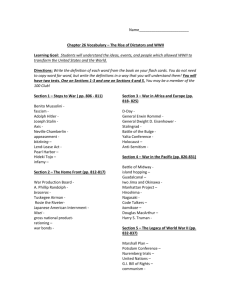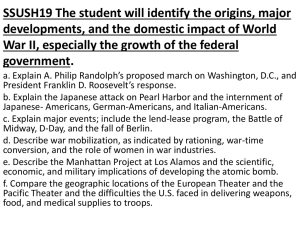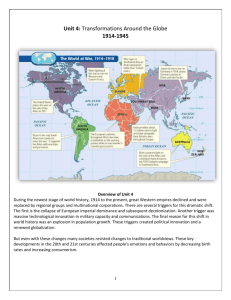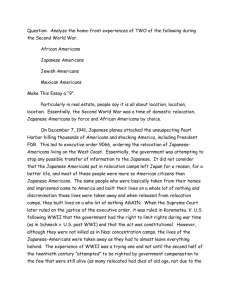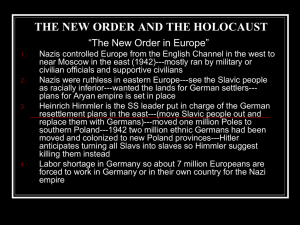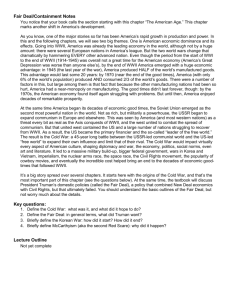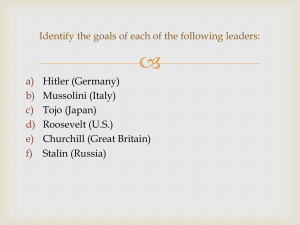AP US History - AnnieFAPNotebook
advertisement
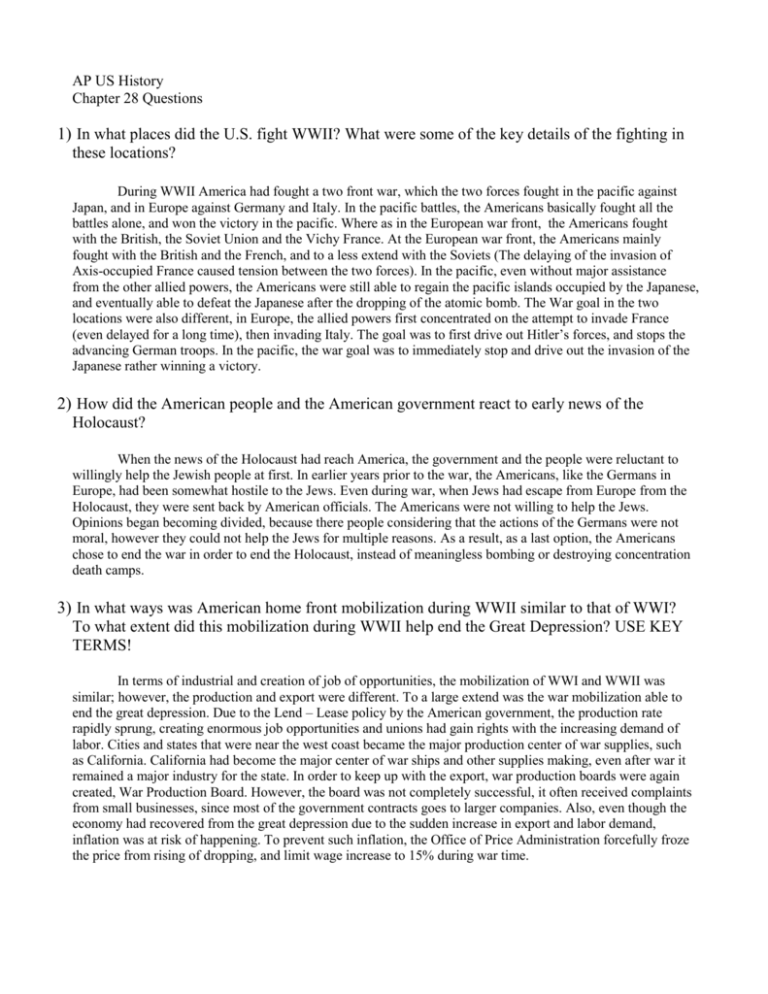
AP US History Chapter 28 Questions 1) In what places did the U.S. fight WWII? What were some of the key details of the fighting in these locations? During WWII America had fought a two front war, which the two forces fought in the pacific against Japan, and in Europe against Germany and Italy. In the pacific battles, the Americans basically fought all the battles alone, and won the victory in the pacific. Where as in the European war front, the Americans fought with the British, the Soviet Union and the Vichy France. At the European war front, the Americans mainly fought with the British and the French, and to a less extend with the Soviets (The delaying of the invasion of Axis-occupied France caused tension between the two forces). In the pacific, even without major assistance from the other allied powers, the Americans were still able to regain the pacific islands occupied by the Japanese, and eventually able to defeat the Japanese after the dropping of the atomic bomb. The War goal in the two locations were also different, in Europe, the allied powers first concentrated on the attempt to invade France (even delayed for a long time), then invading Italy. The goal was to first drive out Hitler’s forces, and stops the advancing German troops. In the pacific, the war goal was to immediately stop and drive out the invasion of the Japanese rather winning a victory. 2) How did the American people and the American government react to early news of the Holocaust? When the news of the Holocaust had reach America, the government and the people were reluctant to willingly help the Jewish people at first. In earlier years prior to the war, the Americans, like the Germans in Europe, had been somewhat hostile to the Jews. Even during war, when Jews had escape from Europe from the Holocaust, they were sent back by American officials. The Americans were not willing to help the Jews. Opinions began becoming divided, because there people considering that the actions of the Germans were not moral, however they could not help the Jews for multiple reasons. As a result, as a last option, the Americans chose to end the war in order to end the Holocaust, instead of meaningless bombing or destroying concentration death camps. 3) In what ways was American home front mobilization during WWII similar to that of WWI? To what extent did this mobilization during WWII help end the Great Depression? USE KEY TERMS! In terms of industrial and creation of job of opportunities, the mobilization of WWI and WWII was similar; however, the production and export were different. To a large extend was the war mobilization able to end the great depression. Due to the Lend – Lease policy by the American government, the production rate rapidly sprung, creating enormous job opportunities and unions had gain rights with the increasing demand of labor. Cities and states that were near the west coast became the major production center of war supplies, such as California. California had become the major center of war ships and other supplies making, even after war it remained a major industry for the state. In order to keep up with the export, war production boards were again created, War Production Board. However, the board was not completely successful, it often received complaints from small businesses, since most of the government contracts goes to larger companies. Also, even though the economy had recovered from the great depression due to the sudden increase in export and labor demand, inflation was at risk of happening. To prevent such inflation, the Office of Price Administration forcefully froze the price from rising of dropping, and limit wage increase to 15% during war time. 4) Describe the situation for African Americans and women during WWII. Even though during the war the large labor demand had created enormous employment opportunities, however, discrimination was still the main issue of the African Americans. A. Philip Randolph threats a march in Washington D.C. to demand no racial discrimination at the war industries. FDR fearing of the march promised a integration to African Americans at the war industries, and to investigate the discrimination at the work places. Also, The Congress of Racial Equality organized large protests against discrimination. At war training camps were racially segregated; however, as the people realized the fact that segregation was only a waste of men power, the camps slowly became integrated. As for women, in response to the labor demands they began to work outside of homes again, and this time they were able to take on jobs which before were considered men’s job. As other job opportunities increased, women began to move into communities which women working at the same professions live together. However, that contributed to the youth crime rate, due to parents both away from home. 5) Describe the situation for Native Americans and Mexican Americans during WWII. WWII became the opportunities that Native Americans were able to leave their reservation and have contact with the outside world. They worked either at war industries or worked as military communicators. The ones who worked in the war industry was the first time that they came in contact with the capitalist American world. Even after war many left to return to the reservations, some chose to stay in the American society. As for Mexican Americans, due to the large labor demand, they were allowed to enter the nation as laborers. However, in the area they lived in, often violence were often, gangs dressed in a specific way to show disobiendence towards the capitalist American society. 6) Describe and evaluate the situation for Japanese Americans and the changing relationship between the U.S. and China during WWII. Japanese Americans during the war faced hostility from the Americans. Unlike the Germans or Italians who were difficult to distinguish, they were easier, so they faced more discrimination. Most immigrants were accused by the people that they were responsible for the attack at Pearl Harbor. Eventually these people were sent to concentration camps, and not released until the war was over. In contrast, the Chinese Americans, as an allied of America during war, their status changed. The Chinese exclusion act was repealed due to the labor demand and the alliance relationship with China. As a result immigrants poured into the country, and they worked at war plants where the most labor demand were. Interment camps- mainly west coast. Korematsu v. Court, that the internment camps were constitutional. The government had the right to do such thing to citizens considered unloyal. President had power to violate the constitution temporarily during war time for the benefit of the country. China had a civil war, America trying to influence the civil war, wishing the nationalist to win. 7) What were the key events that led to victory for America and its allies in Europe, North Africa, and the Pacific? How did American leaders and forces particularly contribute to these key victories? USE KEY TERMS! The major victories in Europe began with the defeat of German troops in Stalingrad, which gave Hitler a great damage since he was attempting for a two – front war. With the liberation of France, the German troops were completely driven out of France and Belgium. The Germans had its last resistance at the battle of Bulge, but was finally defeated, known as the day of victory in Europe. The battle of Leyte Gulf and Okinawa were the major victories at the pacific front for the Americans. With the firebomb attack of the Americans in Tokyo, the Japanese no longer had materials to resist the American attack. With Truman’s decision, two atomic bombs were dropped on to the Japanese mainland, soon the Japanese surrendered, ended WWII.

